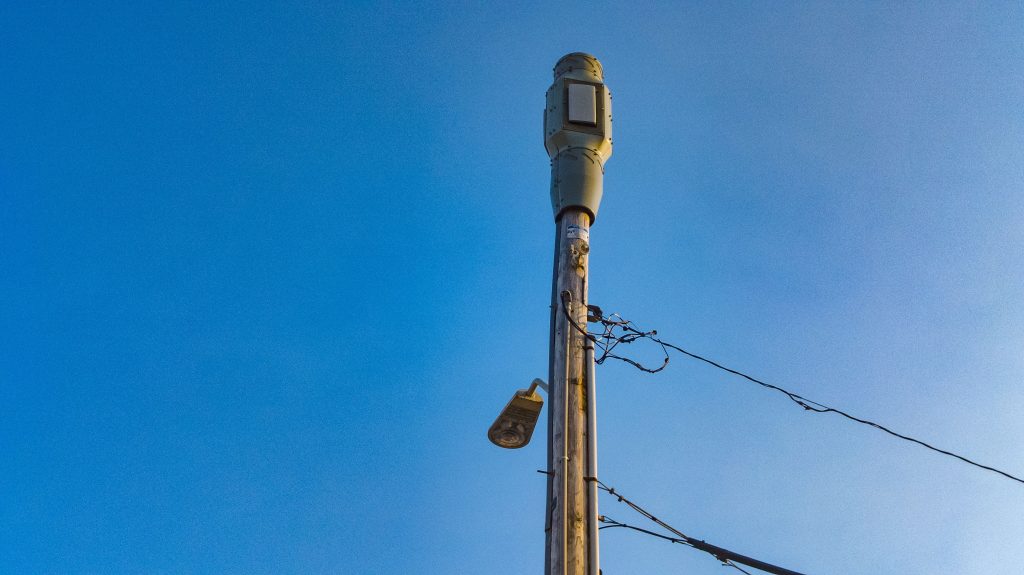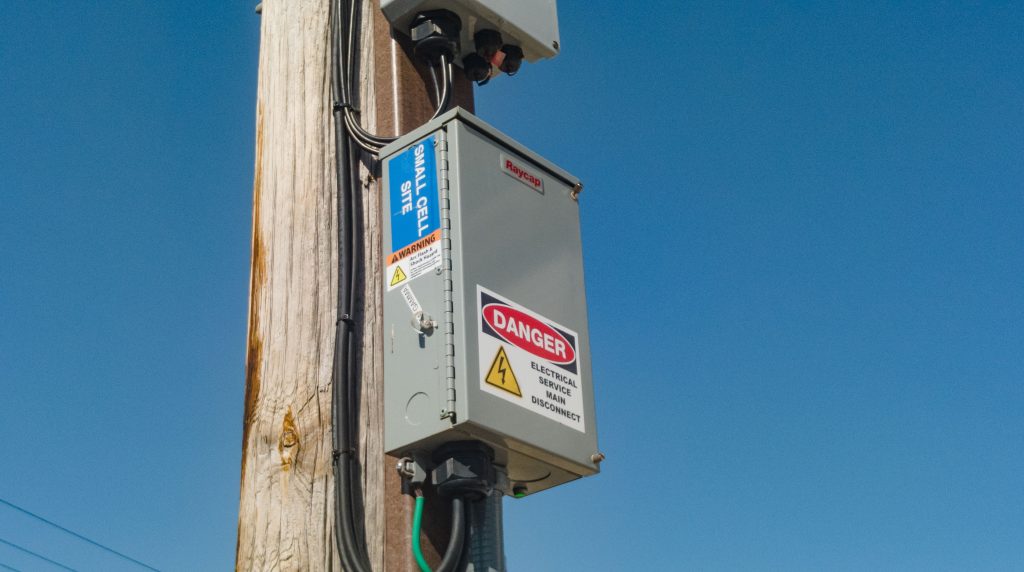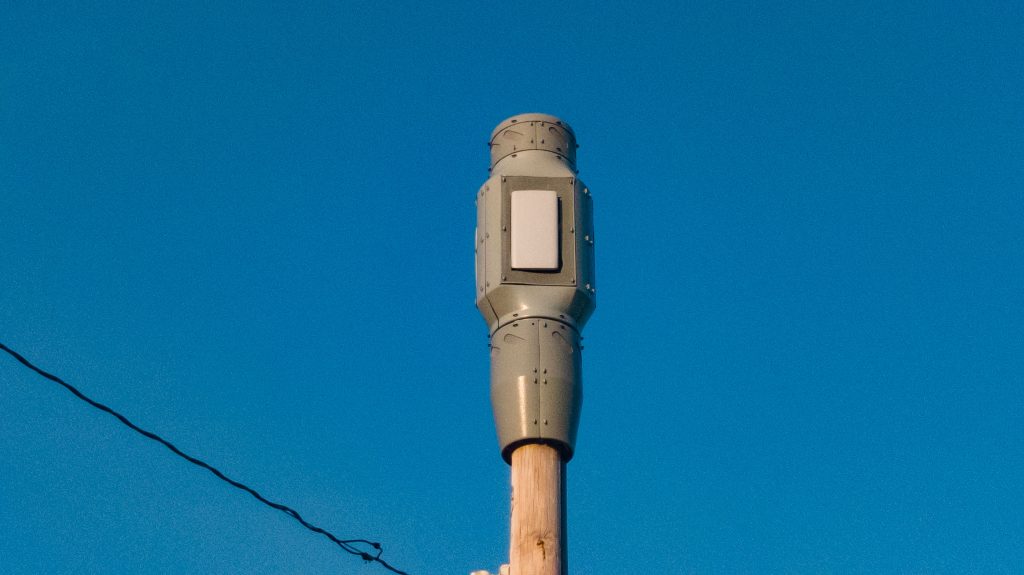Lavallette officials, at their meeting last week, held off on introducing a new ordinance that would regulate the installation of so-called “smart poles” within the borough, which are special monopoles designed to accommodate multiple wireless communications antennas in a single space.
Verizon, after a lengthy discussion with officials that ended in a thinly-veiled threat of litigation, was granted approval over the past two years to install “small cell” facilities on top of a number of existing utility poles in town. The wireless “nodes,” as they are known, are fitted to the top of wooden utility poles and can be identified by their cylindrical shape and bright gray coloration.

A small 5G wireless facility on top of an existing timber pole, Lavallette, N.J., May 2023. (Photo: Shorebeat)

A small 5G wireless facility on top of an existing timber pole, Lavallette, N.J., May 2023. (Photo: Shorebeat)
The new ordinance is designed to keep up with technology, as more wireless providers build out their 5G networks – with some even preparing 6G future service. While 5G signals are present locally for all major carriers, customers have sometimes complained that bandwidth on the 5G network is limited, forcing them to manually turn off 5G service on their devices and deal with lower 4G speeds. As more customers adopt wireless internet service for their homes in place of wired services like cable and FiOS, the network capacity is expected to come into even higher demand, necessitating the installation of additional poles.
Lavallette’s proposed ordinance would set up a permitting process under which a company could build what is known as a “smart pole,” which would house small cell network equipment on a new, dedicated pole rather than an existing timber utility pole. The smart poles would allow more than one provider to mount their equipment on a single pole, ultimately cutting down on the number that would have to be built. It has long been expected that additional major wireless carriers will apply to deploy their own small cell networks in Lavallette. A 2018 ruling by the Federal Communications Commission largely sets the standards for such facilities and limits the power of local governments to regulate network deployments.
The proposed ordinance would allow permits to be granted for companies to build smart poles in the public right-of-way under certain conditions. The pole would have to be “decorative, disguised or camouflaged” in one way or another in order to avoid detracting from the aesthetic appeal of a neighborhood, and can include additional features such as public WiFi, emergency communications equipment for first responders or other public uses. But primarily, the poles would have to allow multiple carriers at once – a practice also known as co-location.
The small cells would be limited to an enclosure attached to the pole with an area of no more than 6 cubic feet, with a maximum of all antennas encompassing no more than 25 cubic feet. A pole owner would be required to enter into a right-of-way use agreement with the borough, place money in an escrow account, and agree to build the pole to specifications outlined in the ordinance. No smart poles could be located within 200 feet of another.
Lavallette would maintain a “wireless siting plan” by which pole owners – which may not be wireless providers themselves, but companies that lease space to providers – would have to abide, locating new poles within 25-feet of previously-specified locations. Once an application is filed, the applicant must be notified within 10 days as to whether their application is considered complete. The borough would then have 60 days to grant or deny a permit to place a wireless array on an existing pole, or 90 days to decide on a new pole. Pole owners would pay a $500 application fee and, if the application is approved by the borough’s construction officials, place $5,000 in an escrow account or $7,500 if any road openings are required.
The borough itself would have a right of first refusal to place its own equipment on privately-owned smart poles, including 911 service, security cameras, public WiFi or a number of other, similar uses, before it is offered to commercial providers. The borough would be responsible for paying the electricity bill for its own equipment.

A small 5G wireless facility on top of an existing timber pole, Lavallette, N.J., May 2023. (Photo: Shorebeat)
“There is much in that ordinance that is not in the best interests of Lavallette,” said Councilwoman Joanne Filippone, saying she would oppose the measure as currently written. “I believe it gives too much power to an outside company for their own gratification. Our current ordinance on the 5G deployment is good, but it has some holes. My thought was that this would plug those holes to make the ordinance stronger, but instead … it puts you into a contract with a company to put up poles and they invite other companies to put their nodes up there.”
While the purpose of smart poles is to allow multiple providers to share space on a single pole, Filippone said the ordinance would “allow more poles, not less” since the application process would be more streamlined and result in a quicker approval if the pole proposal matched the requirements.
“We have not been approached for other providers for 5G nodes – we may be in the future – and our current ordinance does not allow more than one carrier on one pole,” Filippone continued. “I am vehemently opposed to the details of this particular ordinance … I would postpone it indefinitely if I could.”
Ironically, in other island towns, residents have specifically requested co-locating service providers with smart poles. The issue has been brought up during discussions among the Seaside Heights and Brick Township councils, where residents have said they believe the practice would cut down on the number of high towers being placed on both temporary and permanent bases. Other towns across New Jersey have codified Filippone’s vision, however.
In North Wildwood, the municipality partnered with a single company to build out a network of poles which offer shared space to providers, another approach that was mentioned at Lavallette’s most recent council meeting.
While no vote was taken on the ordinance last week, it is expected to come before the borough council again in the near future – and Lavallette could prove once again to be one of New Jersey’s latest battlegrounds where 5G deployment is being critically debated.

Advertisement

Ortley Beach & North Beaches
Landmark Ortley Beach Breakfast Spot Looks to Expand

Ortley Beach & North Beaches
‘Temporary’ 70-Foot Cell Tower on Route 35 in Ocean Beach OK’d to Return

Seaside Heights & Seaside Park
Beloved South Seaside Park Restaurant Will Remain Open As Developer Seeks to Demolish Block

Seaside Heights & Seaside Park
In Seaside Heights, A $50M Flagship Building Rises Over the Boulevard in a Famed Location

Police, Fire & Courts
Ocean County Sheriff Establishes Drone Command Center in Seaside Heights Amid New Video





